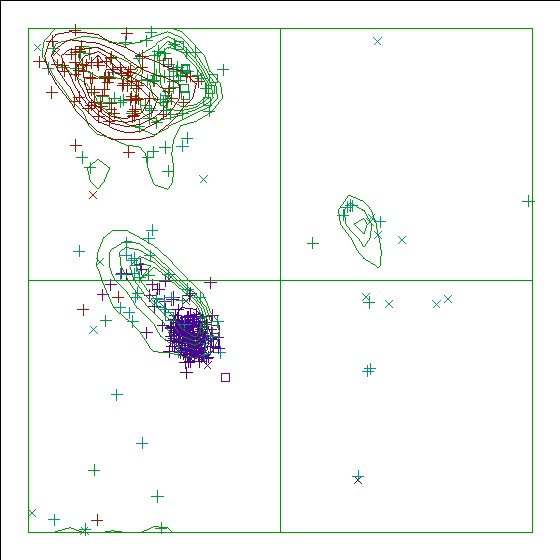
8 ARG ( 8 ) 20 ARG ( 20 ) 36 ARG ( 36 ) 37 ARG ( 37 ) 51 ARG ( 51 ) 54 ARG ( 54 ) 64 ARG ( 64 ) 72 ARG ( 72 ) 97 ARG ( 97 ) 125 ARG ( 125 ) 130 ARG ( 130 ) 137 ARG ( 137 ) 161 ARG ( 161 ) 171 ARG ( 171 ) 174 ARG ( 174 ) 247 ARG ( 247 ) 268 ARG ( 268 ) 276 ARG ( 276 ) 279 ARG ( 279 ) 283 ARG ( 283 ) 297 ARG ( 297 ) 324 ARG ( 324 ) 354 ARG ( 354 ) 368 ARG ( 368 ) 369 ARG ( 369 ) 373 ARG ( 373 ) 375 ARG ( 375 ) 383 ARG ( 383 ) 397 ARG ( 397 ) 412 ARG ( 412 ) 420 ARG ( 420 )
190 TYR ( 190 ) 194 TYR ( 194 ) 197 TYR ( 197 ) 323 TYR ( 323 ) 341 TYR ( 341 ) 406 TYR ( 406 )
23 PHE ( 23 ) 162 PHE ( 162 ) 179 PHE ( 179 ) 365 PHE ( 365 )
3 ASP ( 3 ) 12 ASP ( 12 ) 26 ASP ( 26 ) 67 ASP ( 67 ) 83 ASP ( 83 ) 90 ASP ( 90 ) 109 ASP ( 109 ) 116 ASP ( 116 ) 133 ASP ( 133 ) 150 ASP ( 150 ) 182 ASP ( 182 ) 202 ASP ( 202 ) 216 ASP ( 216 ) 255 ASP ( 255 ) 288 ASP ( 288 ) 300 ASP ( 300 ) 332 ASP ( 332 ) 364 ASP ( 364 )
16 GLU ( 16 ) 50 GLU ( 50 ) 66 GLU ( 66 ) 74 GLU ( 74 ) 80 GLU ( 80 ) 81 GLU ( 81 ) 95 GLU ( 95 ) 117 GLU ( 117 ) 122 GLU ( 122 ) 186 GLU ( 186 ) 192 GLU ( 192 ) 225 GLU ( 225 ) 249 GLU ( 249 ) 270 GLU ( 270 ) 291 GLU ( 291 ) 306 GLU ( 306 ) 344 GLU ( 344 ) 355 GLU ( 355 ) 414 GLU ( 414 ) 427 GLU ( 427 )
Improper dihedrals are a measure of the chirality/planarity of the structure at a specific atom. Values around -35 or +35 are expected for chiral atoms, and values around 0 for planar atoms. Planar side chains are left out of the calculations, these are better handled by the planarity checks.
Three numbers are given for each atom in the table. The first is the Z-score for the improper dihedral. The second number is the measured improper dihedral. The third number is the expected value for this atom type. A final column contains an extra warning if the chirality for an atom is opposite to the expected value.
113 VAL ( 113 ) CA -4.6 23.5 33.6 199 VAL ( 199 ) CB 4.4 -22.9 -33.6 240 VAL ( 240 ) CA -4.1 24.6 33.6 281 LEU ( 281 ) CA -4.3 25.1 34.4 290 VAL ( 290 ) CA -5.0 22.6 33.6 309 THR ( 309 ) CA -4.3 24.5 34.2 429 ILE ( 429 ) CA -4.1 25.4 33.8
Improper dihedral RMS Z-score : 0.977
Note: Chain names are OK
All chain names assigned to polymer molecules are unique, and all
residue numbers are strictly increasing within each chain.
Note: Weights checked OK
All atomic occupancy factors ('weights') fall in the 0.0--1.0 range.
Geometric checks
Note: No missing atoms detected
All expected atoms are present.
Note: OXT check OK
All required C-terminal oxygen atoms are present.
Note: No extra C-terminal groups found
No C-terminal groups are present for non C-terminal residues
Note: All bond lengths OK
All bond lengths are in agreement with standard bond lengths using
a tolerance of 4 sigma (both standard values and sigma for amino
acid residues have been taken from Engh and Huber [REF], for
DNA/RNA from Parkinson et al [REF])
Note: Normal bond length variability
Bond lengths were found to deviate normally from the standard bond
lengths (values for Protein residues were taken from Engh and Huber
[REF], for DNA/RNA from Parkinson et al [REF]).
RMS Z-score for bond lengths: 0.759
RMS-deviation in bond distances: 0.016
Note: No bond length directionality
Comparison of bond distances with Engh and Huber [REF] standard
values for protein residues and Parkinson et al [REF] values for
DNA/RNA does not show significant systematic deviations.
Warning: Unusual bond angles
The bond angles listed in the table below were found to deviate
more than 4 sigma from standard bond angles (both standard values
and sigma for protein residues have been taken from Engh and Huber
[REF], for DNA/RNA from Parkinson et al [REF]). In the table below
for each strange angle the bond angle and the number of standard
deviations it differs from the standard values is given. Please
note that disulphide bridges are neglected. Atoms starting with "<"
belong to the previous residue in the sequence.
7 LEU ( 7 ) C CA CB 118.465 4.4 10 GLU ( 10 ) N CA CB 119.077 5.0 10 GLU ( 10 ) CB CG CD 105.500 -4.2 11 PRO ( 11 ) <O <C N 128.031 4.3 11 PRO ( 11 ) <CA <C N 108.809 -5.4 12 ASP ( 12 ) C CA CB 118.272 4.3 21 ARG ( 21 ) <C N CA 130.237 4.7 21 ARG ( 21 ) N CA CB 118.606 4.8 21 ARG ( 21 ) CA CB CG 124.914 5.4 21 ARG ( 21 ) CD NE CZ 135.754 7.8 21 ARG ( 21 ) NE CZ NH1 130.949 5.8 34 GLU ( 34 ) CA CB CG 122.696 4.3 35 GLU ( 35 ) CG CD OE2 107.853 -4.6 36 ARG ( 36 ) CG CD NE 117.479 4.1 37 ARG ( 37 ) CA CB CG 122.603 4.3 37 ARG ( 37 ) CD NE CZ 137.277 8.7 41 GLN ( 41 ) CB CG CD 104.538 -4.7 41 GLN ( 41 ) NE2 CD OE1 127.227 4.6 42 VAL ( 42 ) N CA CB 118.229 4.5 44 THR ( 44 ) <C N CA 130.760 5.0 44 THR ( 44 ) CA CB CG2 118.385 4.6 46 ASN ( 46 ) CA CB CG 117.557 5.0 51 ARG ( 51 ) CD NE CZ 129.851 4.5 52 ASN ( 52 ) C CA CB 119.138 4.8 52 ASN ( 52 ) ND2 CG OD1 113.582 -9.0And so on for a total of 212 lines
RMS Z-score for bond angles: 1.928
RMS-deviation in bond angles: 3.639
Error: Side chain planarity problems
The side chains of the residues listed in the table below contain a
planar group that was found to deviate from planarity by more than
4.0 times the expected value. For an amino acid residue that has a
side chain with a planar group, the RMS deviation of the atoms to a
least squares plane was determined. The number in the table is the
number of standard deviations this RMS value deviates from the
expected value (0.0).
279 ARG ( 279 ) 5.254
4 PRO ( 4 ) 0.15 LOW 107 PRO ( 107 ) 0.11 LOW 196 PRO ( 196 ) 0.15 LOW 236 PRO ( 236 ) 0.14 LOW 265 PRO ( 265 ) 0.20 LOW
These scores give an impression of how ``normal'' the torsion angles in protein residues are. All torsion angles except omega are used for calculating a `normality' score. Average values and standard deviations were obtained from the residues in the WHAT IF database. These are used to calculate Z-scores. A residue with a Z-score of below -2.0 is poor, and a score of less than -3.0 is worrying. For such residues more than one torsion angle is in a highly unlikely position.
363 TRP ( 363 ) -3.0062 352 THR ( 352 ) -2.7884 348 PRO ( 348 ) -2.7713 147 SER ( 147 ) -2.6014 237 THR ( 237 ) -2.4242 10 GLU ( 10 ) -2.3462 228 ASP ( 228 ) -2.2876 385 VAL ( 385 ) -2.2753 229 THR ( 229 ) -2.1499 199 VAL ( 199 ) -2.1345 326 ILE ( 326 ) -2.1302 426 LEU ( 426 ) -2.1167 392 GLY ( 392 ) -2.0891 225 GLU ( 225 ) -2.0846 276 ARG ( 276 ) -2.0415 68 ILE ( 68 ) -2.0047
Residues with ``forbidden'' phi-psi combinations are listed, as well as residues with unusual omega angles (deviating by more than 3 sigma from the normal value). Please note that it is normal if about 5 percent of the residues is listed here as having unusual phi-psi combinations.
10 GLU ( 10 ) Poor phi/psi 158 THR ( 158 ) Poor phi/psi 161 ARG ( 161 ) Poor phi/psi 210 LEU ( 210 ) PRO omega poor 211 PRO ( 211 ) Poor PRO-phi 226 GLU ( 226 ) Poor phi/psi 228 ASP ( 228 ) Poor phi/psi 229 THR ( 229 ) Poor phi/psi 256 LEU ( 256 ) PRO omega poor 257 PRO ( 257 ) Poor PRO-phi 265 PRO ( 265 ) Poor PRO-phi 275 GLY ( 275 ) Poor phi/psi 276 ARG ( 276 ) Poor phi/psi 279 ARG ( 279 ) Poor phi/psi 280 GLY ( 280 ) Poor phi/psi 348 PRO ( 348 ) Poor PRO-phi 349 ALA ( 349 ) Poor phi/psi 356 ILE ( 356 ) Poor phi/psi 363 TRP ( 363 ) Poor phi/psi 377 LYS ( 377 ) Poor phi/psi 380 LYS ( 380 ) Poor phi/psi 392 GLY ( 392 ) omega poor 425 GLY ( 425 ) Poor phi/psi
Ramachandran Z-score : -1.891
Warning: Omega angles too tightly restrained
The omega angles for trans-peptide bonds in a structure are
expected to give a gaussian distribution with the average around
+178 degrees and a standard deviation around 5.5 degrees. These
expected values were obtained from very accurately determined
structures. Many protein structures are too tightly constrained.
This seems to be the case with the current structure, as the
observed standard deviation is below 4.0 degrees.
Standard deviation of omega values : 1.869
Note: chi-1/chi-2 angle correlation Z-score OK
The score expressing how well the chi-1/chi-2 angles of all residues
are corresponding to the populated areas in the database is
within expected ranges for well-refined structures.
chi-1/chi-2 correlation Z-score : -2.375
Note: Ramachandran plot
In this Ramachandran plot X-signs represent glycines, squares represent
prolines and small plus-signs represent the other residues. If too many
plus-signs fall outside the contoured areas then the molecule is poorly
refined (or worse).
In a colour picture, the residues that are part of a helix are shown in blue, strand residues in red. "Allowed" regions for helical residues are drawn in blue, for strand residues in red, and for all other residues in green.

Chain without chain identifier
Accessibility related checks
Note: Inside/Outside residue distribution normal
The distribution of residue types over the inside and the outside of the
protein is normal.
inside/outside RMS Z-score : 1.009
Note: Inside/Outside RMS Z-score plot
The Inside/Outside distribution normality RMS Z-score over a 15
residue window is plotted as function of the residue number. High
areas in the plot (above 1.5) indicate unusual inside/outside
patterns.
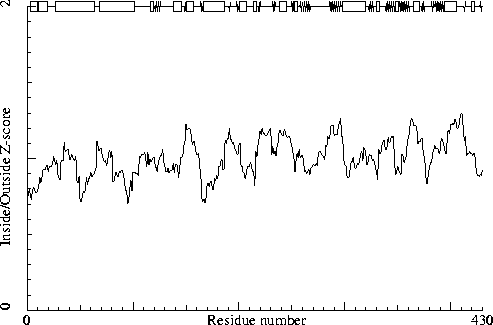
Chain without chain identifier
Secondary structure
Note: Secondary structure
This is the secondary structure according to DSSP. Only helix (H), strand
(S), turn (T) and coil (blank) are shown. [REF]
DBG> SSBOND cards to be written: 0
10 20 30 40 50 60
| | | | | |
1 - 60 MLDPNLLRNEPDAVAEKLARRGFKLDVDKLGALEERRKVLQVKTENLQAERNSRSKSIGQ
1 - 60 HHHHHH HHHHHHHHHTTT HHHHHHHHHHHHHHHHHHHHHHHHHHHHHHHHHH
70 80 90 100 110 120
| | | | | |
61 - 120 AKARGEDIEPLRLEVNKLGEELDAAKAELDALQAEIRDIALTIPNLPADEVPVGKDENDN
61 - 120 HHHTT HHHHHHHHHHHHHHHHHHHHHHHHHHHHHHHHHT TTT TT333
130 140 150 160 170 180
| | | | | |
121 - 180 VEVSRWGTPREFDFEVRDHVTLGEMHSGLDFAAAVKLTGSRFVVMKGQIARMHRALSQFM
121 - 180 SSSSSST TT HHHHHHHTT SSHHHHHHHT TT SS HHHHHHHHHHHHHH
190 200 210 220 230 240
| | | | | |
181 - 240 LDLHTEQHGYSENYVPYLVNQDTLYGTGQLPKFAGDLFHTRPLEEEADTSNYALIPTAEV
181 - 240 HHHHHHTT SS TSS HHHHHHHT TTTT333T SS TT SSS TTTHH
250 260 270 280 290 300
| | | | | |
241 - 300 PLTNLVRGEIIDEDDLPIKMTAHTPCFRSEAGSYGRDTRGLIRMHQFDKVEMVQIVRPED
241 - 300 HHHHTTTT SSS333 SSSSSSSSSS T TT T TSSSSSSSSSSS 333
310 320 330 340 350 360
| | | | | |
301 - 360 SMAALEEMTGHAEKVLQLLGLPYRKIILCTGDMGFGACKTYDLEVWIPAQNTYREISSCS
301 - 360 HHHHHHHHHHHHHHHHHHHT SSSSS 333T TT TSSSSSSSSS333TSSSSSSSSS
370 380 390 400 410 420
| | | | | |
361 - 420 NVWDFQARRMQARCRSKSDKKTRLVHTLNGSGLAVGRTLVAVMENYQQADGRIEVPEVLR
361 - 420 S TTHHHHHHT SSS TTT SSS SSSSSSSSSHHHHHHHHHHHT TTT SS TTT3
430
|
421 - 430 PYMNGLEYIG
421 - 430 33TTT SS
The contact distances of all atom pairs have been checked. Two atoms are said to `bump' if they are closer than the sum of their Van der Waals radii minus 0.40 Angstrom. For hydrogen bonded pairs a tolerance of 0.55 Angstrom is used. The first number in the table tells you how much shorter that specific contact is than the acceptable limit. The second distance is the distance between the centers of the two atoms.
The last text-item on each line represents the status of the atom pair. The text `INTRA' means that the bump is between atoms that are explicitly listed in the PDB file. `INTER' means it is an inter-symmetry bump. If the final column contains the text 'HB', the bump criterium was relaxed because there could be a hydrogen bond. Similarly relaxed criteria are used for 1--3 and 1--4 interactions (listed as 'B2' and 'B3', respectively). If the last column is 'BF', the sum of the B-factors of the atoms is higher than 80, which makes the appearance of the bump somewhat less severe because the atoms probably aren't there anyway.
Bumps between atoms for which the sum of their occupancies is lower than one are not reported. In any case, each bump is listed in only one direction.
361 ASN ( 361 ) ND2 -- 363 TRP ( 363 ) N 0.432 2.568 INTRA 10 GLU ( 10 ) N -- 11 PRO ( 11 ) CD 0.345 2.655 INTRA BF 184 HIS ( 184 ) ND1 -- 188 HIS ( 188 ) CD2 0.296 2.804 INTRA 329 CYS ( 329 ) O -- 330 THR ( 330 ) C 0.285 2.515 INTRA 415 VAL ( 415 ) O -- 416 PRO ( 416 ) C 0.226 2.574 INTRA 425 GLY ( 425 ) O -- 426 LEU ( 426 ) C 0.213 2.587 INTRA 10 GLU ( 10 ) O -- 11 PRO ( 11 ) C 0.202 2.598 INTRA BF 69 GLU ( 69 ) N -- 70 PRO ( 70 ) CD 0.197 2.803 INTRA BF 305 LEU ( 305 ) O -- 309 THR ( 309 ) CG2 0.190 2.610 INTRA 175 ALA ( 175 ) O -- 176 LEU ( 176 ) C 0.175 2.625 INTRA 361 ASN ( 361 ) ND2 -- 362 VAL ( 362 ) N 0.152 2.848 INTRA 348 PRO ( 348 ) O -- 350 GLN ( 350 ) N 0.152 2.548 INTRA 122 GLU ( 122 ) CD -- 125 ARG ( 125 ) NH1 0.148 2.952 INTRA 192 GLU ( 192 ) C -- 193 ASN ( 193 ) ND2 0.147 2.953 INTRA 362 VAL ( 362 ) O -- 363 TRP ( 363 ) C 0.143 2.657 INTRA 34 GLU ( 34 ) CD -- 37 ARG ( 37 ) NH1 0.137 2.963 INTRA BF 420 ARG ( 420 ) NH1 -- 427 GLU ( 427 ) CG 0.133 2.967 INTRA BF 171 ARG ( 171 ) NH1 -- 422 TYR ( 422 ) O 0.124 2.576 INTRA 366 GLN ( 366 ) O -- 367 ALA ( 367 ) C 0.122 2.678 INTRA 128 THR ( 128 ) O -- 129 PRO ( 129 ) C 0.120 2.680 INTRA 161 ARG ( 161 ) CZ -- 282 ILE ( 282 ) CD1 0.119 3.081 INTRA BF 244 ASN ( 244 ) O -- 245 LEU ( 245 ) C 0.112 2.688 INTRA 1 MET ( 1 ) N -- 369 ARG ( 369 ) CG 0.106 2.994 INTRA 308 MET ( 308 ) CE -- 388 LEU ( 388 ) CB 0.103 3.097 INTRA 55 SER ( 55 ) O -- 56 LYS ( 56 ) C 0.101 2.699 INTRAAnd so on for a total of 80 lines
The packing environment of the residues is compared with the average packing environment for all residues of the same type in good PDB files. A low packing score can indicate one of several things: Poor packing, misthreading of the sequence through the density, crystal contacts, contacts with a co-factor, or the residue is part of the active site. It is not uncommon to see a few of these, but in any case this requires further inspection of the residue.
194 TYR ( 194 ) -8.50 279 ARG ( 279 ) -7.33 223 LEU ( 223 ) -6.62 283 ARG ( 283 ) -5.86 350 GLN ( 350 ) -5.58 9 ASN ( 9 ) -5.38 115 LYS ( 115 ) -5.37 125 ARG ( 125 ) -5.36 225 GLU ( 225 ) -5.17 276 ARG ( 276 ) -5.06
The table below lists the first and last residue in each stretch found, as well as the average residue score of the series.
223 LEU ( 223 ) --- 225 GLU ( 225 ) -5.30
Average for range 1 - 430 : -0.785
Note: Quality value plot
The quality value smoothed over a 10 residue window is plotted as
function of the residue number. Low areas in the plot (below
-2.0) indicate "unusual" packing.
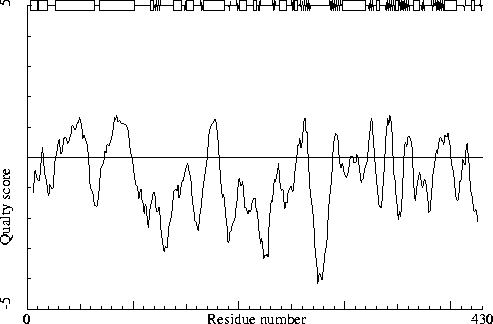
Chain without chain identifier
Warning: Low packing Z-score for some residues
The residues listed in the table below have an unusual packing
environment according to the 2nd generation quality check. The score
listed in the table is a packing normality Z-score: positive means
better than average, negative means worse than average. Only residues
scoring less than -2.50 are listed here. These are the "unusual"
residues in the structure, so it will be interesting to take a
special look at them.
194 TYR ( 194 ) -2.61 222 PRO ( 222 ) -2.56
The table below lists the first and last residue in each stretch found, as well as the average residue Z-score of the series.
279 ARG ( 279 ) --- 282 ILE ( 282 ) -2.08
All contacts : Average = -0.094 Z-score = -0.47
BB-BB contacts : Average = 0.151 Z-score = 1.09
BB-SC contacts : Average = -0.325 Z-score = -1.70
SC-BB contacts : Average = -0.017 Z-score = 0.07
SC-SC contacts : Average = -0.250 Z-score = -1.06
Note: Second generation quality Z-score plot
The second generation quality Z-score smoothed over a 10 residue window
is plotted as function of the residue number. Low areas in the plot (below
-1.3) indicate "unusual" packing.
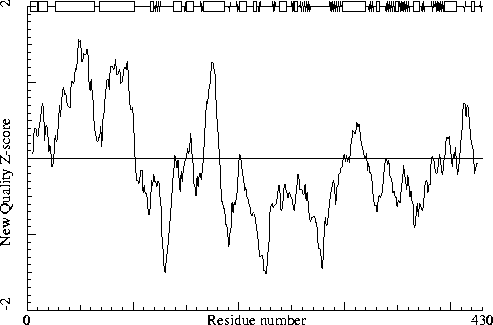
Chain without chain identifier
Note: Backbone oxygen evaluation OK
All residues for which the local backbone conformation could be
found in the WHAT IF database have a normal backbone oxygen
position.
Warning: Unusual rotamers
The residues listed in the table below have a rotamer that is not
seen very often in the database of solved protein structures. This
option determines for every residue the position specific chi-1
rotamer distribution. Thereafter it verified whether the actual
residue in the molecule has the most preferred rotamer or not. If
the actual rotamer is the preferred one, the score is 1.0. If the
actual rotamer is unique, the score is 0.0. If there are two
preferred rotamers, with a population distribution of 3:2 and your
rotamer sits in the lesser populated rotamer, the score will be
0.66. No value will be given if insufficient hits are found in the
database.
It is not necessarily an error if a few residues have rotamer values below 0.3, but careful inspection of all residues with these low values could be worth it.
389 ASN ( 389 ) 0.38 289 LYS ( 289 ) 0.38 125 ARG ( 125 ) 0.38 55 SER ( 55 ) 0.39 360 SER ( 360 ) 0.40
For this check, backbone conformations are compared with database structures using C-alpha superpositions with some restraints on the backbone oxygen positions.
A residue mentioned in the table can be part of a strange loop, or there might be something wrong with it or its directly surrounding residues. There are a few of these in every protein, but in any case it is worth looking at!
158 THR ( 158 ) 0 210 LEU ( 210 ) 0 228 ASP ( 228 ) 0 229 THR ( 229 ) 0 276 ARG ( 276 ) 0 363 TRP ( 363 ) 0 377 LYS ( 377 ) 0 379 ASP ( 379 ) 0 393 LEU ( 393 ) 0 147 SER ( 147 ) 1 166 LYS ( 166 ) 1 224 GLU ( 224 ) 1 226 GLU ( 226 ) 1 256 LEU ( 256 ) 1 161 ARG ( 161 ) 2 168 GLN ( 168 ) 2 227 ALA ( 227 ) 2 364 ASP ( 364 ) 2
Backbone conformation Z-score : -0.113
B-factor analysis
Note: Average B-factor OK
The average B-factor of buried atoms is within expected values for
a room-temperature X-ray study.
Average B-factor for buried atoms : 24.861
Note: Number of buried atoms with low B-factor is OK
For protein structures determined at room temperature, no more than
about 1 percent of the B factors of buried atoms is below 5.0.
Percentage of buried atoms with B less than 5 : 0.26
Note: B-factor distribution normal
The distribution of B-factors within residues is within expected
ranges. A value over 1.5 here would mean that the B-factors show
signs of over-refinement.
RMS Z-score : 0.634 over 2836 bonds
Average difference in B over a bond : 1.84
RMS difference in B over a bond : 2.41
Note: B-factor plot
The average atomic B-factor per residue is plotted as function of
the residue number.
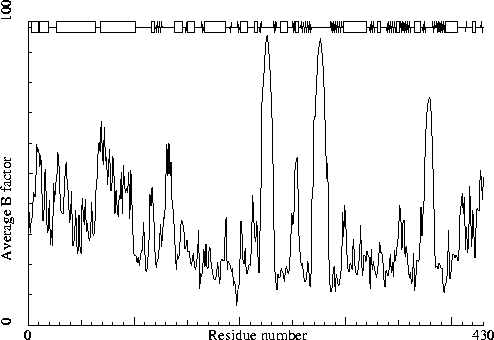
Chain without chain identifier
Hydrogen bond related checks
Error: HIS, ASN, GLN side chain flips
Listed here are Histidine, Asparagine or Glutamine residues for
which the orientation determined from hydrogen bonding analysis are
different from the assignment given in the input. Either they could
form energetically more favorable hydrogen bonds if the terminal
group was rotated by 180 degrees, or there is no assignment in the
input file (atom type 'A') but an assignment could be made. If a
residue is marked ``flexible'' the flipped conformation is only
slightly better than the non-flipped conformation.
93 GLN ( 93 ) 188 HIS ( 188 ) 219 HIS ( 219 ) 361 ASN ( 361 )
In the table below all normal histidine residues are listed. The assignment based on the geometry of the residue is listed first, together with the RMS Z-score for the fit to the Engh and Huber parameters. For all residues where the H-bond assignment is different, the assignment is listed in the last columns, together with its RMS Z-score to the Engh and Huber parameters.
As always, the RMS Z-scores should be close to 1.0 if the residues were restrained to the Engh and Huber parameters during refinement.
Please note that because the differences between the geometries of the different types are small it is possible that the geometric assignment given here does not correspond to the type used in refinement. This is especially true if the RMS Z-scores are much higher than 1.0.
If the two assignments differ, or the ``geometry'' RMS Z-score is high, it is advisable to verify the hydrogen bond assignment, check the HIS type used during the refinement and possibly adjust it.
139 HIS ( 139 ) HIS-H 0.38 HIS-D 0.53 146 HIS ( 146 ) HIS-H 0.71 HIS-E 0.88 173 HIS ( 173 ) HIS-E 1.06 184 HIS ( 184 ) HIS-E 0.65 188 HIS ( 188 ) HIS-E 1.25 HIS-D 1.26 219 HIS ( 219 ) HIS-H 0.50 HIS-E 0.72 263 HIS ( 263 ) HIS-E 0.79 285 HIS ( 285 ) HIS-E 1.08 HIS-D 1.25 311 HIS ( 311 ) HIS-E 0.79 386 HIS ( 386 ) HIS-H 0.74 HIS-E 0.82
Hydrogen bond donors that are buried inside the protein normally use all of their hydrogens to form hydrogen bonds within the protein. If there are any non hydrogen bonded buried hydrogen bond donors in the structure they will be listed here. In very good structures the number of listed atoms will tend to zero.
1 MET ( 1 ) N 12 ASP ( 12 ) N 20 ARG ( 20 ) NE 44 THR ( 44 ) OG1 120 ASN ( 120 ) N 140 VAL ( 140 ) N 162 PHE ( 162 ) N 212 LYS ( 212 ) N 218 PHE ( 218 ) N 226 GLU ( 226 ) N 230 SER ( 230 ) N 237 THR ( 237 ) N 238 ALA ( 238 ) N 270 GLU ( 270 ) N 279 ARG ( 279 ) N 280 GLY ( 280 ) N 281 LEU ( 281 ) N 286 GLN ( 286 ) N 324 ARG ( 324 ) NE 340 THR ( 340 ) N 352 THR ( 352 ) N 353 TYR ( 353 ) N 364 ASP ( 364 ) N 366 GLN ( 366 ) N 367 ALA ( 367 ) N 369 ARG ( 369 ) NE 369 ARG ( 369 ) NH2 377 LYS ( 377 ) N 379 ASP ( 379 ) N 381 LYS ( 381 ) N 412 ARG ( 412 ) NE 420 ARG ( 420 ) N
The second part of the table mostly gives an impression of how well the model conforms to common refinement constraint values. The first part of the table shows a number of constraint-independent quality indicators.
Structure Z-scores, positive is better than average:
1st generation packing quality : -0.714 2nd generation packing quality : -0.468 Ramachandran plot appearance : -1.891 chi-1/chi-2 rotamer normality : -2.375 Backbone conformation : -0.113
Bond lengths : 0.759 Bond angles : 1.928 Omega angle restraints : 0.340 (tight) Side chain planarity : 0.792 Improper dihedral distribution : 0.977 B-factor distribution : 0.634 Inside/Outside distribution : 1.009